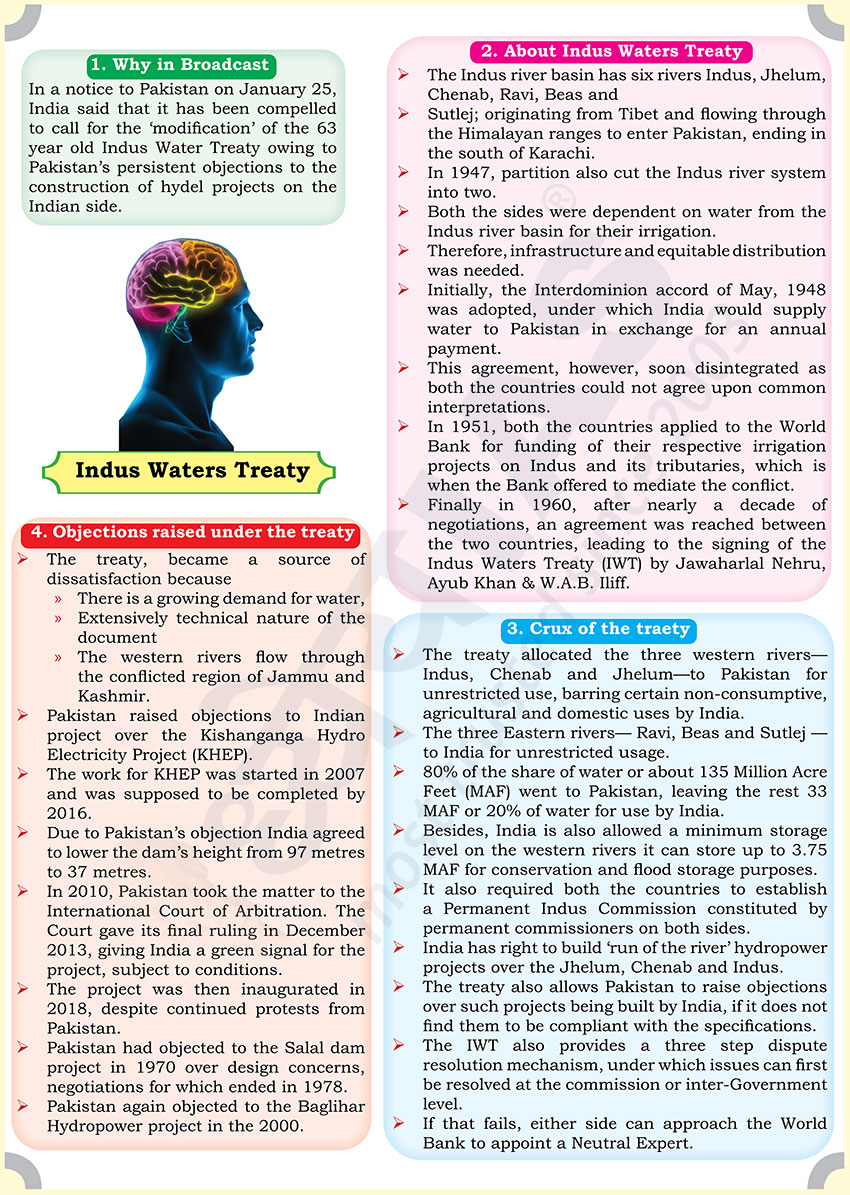Brain-booster /
16 Feb 2023
Brain Booster for UPSC & State PCS Examination (Topic: Indus Waters Treaty)

Why in Broadcast?
- In a notice to Pakistan on January 25, India said that it has been
compelled to call for the ‘modification’ of the 63 year old Indus Water
Treaty owing to Pakistan’s persistent objections to the construction of
hydel projects on the Indian side.
About Indus Waters Treaty
- The Indus river basin has six rivers Indus, Jhelum, Chenab, Ravi, Beas
and
- Sutlej; originating from Tibet and flowing through the Himalayan ranges
to enter Pakistan, ending in the south of Karachi.
- In 1947, partition also cut the Indus river system into two.
- Both the sides were dependent on water from the Indus river basin for
their irrigation.
- Therefore, infrastructure and equitable distribution was needed.
- Initially, the Interdominion accord of May, 1948 was adopted, under
which India would supply water to Pakistan in exchange for an annual
payment.
- This agreement, however, soon disintegrated as both the countries could
not agree upon common interpretations.
- In 1951, both the countries applied to the World Bank for funding of
their respective irrigation projects on Indus and its tributaries, which is
when the Bank offered to mediate the conflict.
- Finally in 1960, after nearly a decade of negotiations, an agreement was
reached between the two countries, leading to the signing of the Indus
Waters Treaty (IWT) by Jawaharlal Nehru, Ayub Khan & W.A.B. Iliff.
Crux of the traety
- The treaty allocated the three western rivers— Indus, Chenab and Jhelum—to
Pakistan for unrestricted use, barring certain non-consumptive, agricultural
and domestic uses by India.
- The three Eastern rivers— Ravi, Beas and Sutlej — to India for
unrestricted usage.
- 80% of the share of water or about 135 Million Acre Feet (MAF) went to
Pakistan, leaving the rest 33 MAF or 20% of water for use by India.
- Besides, India is also allowed a minimum storage level on the western
rivers it can store up to 3.75 MAF for conservation and flood storage
purposes.
- It also required both the countries to establish a Permanent Indus
Commission constituted by permanent commissioners on both sides.
- India has right to build ‘run of the river’ hydropower projects over the
Jhelum, Chenab and Indus.
- The treaty also allows Pakistan to raise objections over such projects
being built by India, if it does not find them to be compliant with the
specifications.
- The IWT also provides a three step dispute resolution mechanism, under
which issues can first be resolved at the commission or inter-Government
level.
- If that fails, either side can approach the World Bank to appoint a
Neutral Expert.
Objections raised under the treaty
- The treaty, became a source of dissatisfaction because
- There is a growing demand for water,
- Extensively technical nature of the document
- The western rivers flow through the conflicted region of Jammu and
Kashmir.
- Pakistan raised objections to Indian project over the Kishanganga Hydro
Electricity Project (KHEP).
- The work for KHEP was started in 2007 and was supposed to be completed
by 2016.
- Due to Pakistan’s objection India agreed to lower the dam’s height from
97 metres to 37 metres.
- In 2010, Pakistan took the matter to the International Court of
Arbitration. The Court gave its final ruling in December 2013, giving India
a green signal for the project, subject to conditions.
- The project was then inaugurated in 2018, despite continued protests
from Pakistan.
- Pakistan had objected to the Salal dam project in 1970 over design
concerns, negotiations for which ended in 1978.
- Pakistan again objected to the Baglihar Hydropower project in the 2000.







